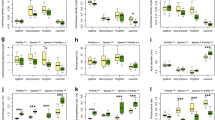Abstract
Plant roots function in the critical role of water and nutrient uptake. Although extensive data exist on functioning of seedling roots, little is known of the actual functionality of the fine roots of mature plants. Although this class of root represents 90% or more of the total root length of a given mature plant, their small size has inhibited detailed studies. Commonly, the critical metrics for studies of root function are root length and total weight, expressed as Specific Root Length. The metric that classifies “fine roots,” root diameter, is rarely a focus except as average diameter, even though this is the primary characteristic from which accurate estimates of surface area and volume can be calculated. Using data from several preliminary experiments, this study shows consistent changes in measured fine root diameter with changes in concentration of some nutrients. Twelve different species demonstrated concentration dependent diameter increases, or decreases, in response to increasing concentrations of nitrate, phosphorus, aluminum or tannic acid. On the other hand, Cacao (Theobroma cacao L) fine roots changed diameter in response to changes in nitrate concentration, but not ammonium. Clearly pattern of diameter change in response to nutrient concentration is dependent on nutrient, species and their interaction. It is suggested that the routine assessment of fine root diameter will be essential to understanding nutrient uptake dynamics.





Similar content being viewed by others
References
Blair LM, Taylor GJ (1997) The nature of interaction between aluminum and manganese on growth and metal accumulation in Triticum aestivum. Environ Exp Bot 37:25–37
Blancaflor EB, Jones DL, Gilroy S (1998) Alterations in the cytoskeleton accompany aluminum-induced growth inhibition and morphological changes in primary roots of maize. Plant Physiol 118:159–172
Bushamuka VN, Zobel RW (1998) Maize and soybean tap, basal and lateral root responses to a stratified acid, Al-toxic soil. Crop Sci 38:416–421
Cahn MD, Zobel RW, Bouldin DR (1989) Relationship between root elongation rate and diameter and duration of growth of lateral roots of maize. Plant Soil 119:271–279
Draper N, Smith H (1998) Applied regression analysis, 3rd ed. Wiley, New York
Hewitt EJ (1966) Sand and water culture methods used in study of plant nutrition. Eastern, London
Kinraide TB (1999) Interactions among Ca2+, Na+ and K+ in salinity toxicity: quantitative resolution of multiple toxic and ameliorative effects. J Exp Bot 50:1495–1505
Kinraide TB (2003) Toxicity factors in acidic forest soils: attempts to evaluate separately the toxic effects of excessive Al3+ and H+ and insufficient Ca2+ and Mg2+ upon root elongation. Eur J Soil Sci 54:323–333
Lyford WH (1975) Rhizography of non-woody roots of trees in the forest floor. In: Torrey JG, Clarkson DT (eds) The development and function of roots. Academic, London, pp 179–196
Marschner H (1995) Mineral nutrition of higher plants. Academic, London, pp 514–517
McCully ME (1987) Selected aspects of the structure and development of field-grown roots with special reference to maize. In: Gregory PJ, Lake JV, Rose DA (eds) Root development and function. Cambridge University Press, Cambridge, pp 53–70
Miller DM (1981) Studies of root function in Zea mays. II. Dimensions of the root system. Can J Bot 59:811–818
Ryser P (1998) Intra- and interspecific variation in root length, root turnover and the underlying parameters. In: Lambers H, Poorter H, VanVuuren MMI (eds) Inherent variation in plant growth, physiological mechanisms and ecological consequences. Backhuys, Leiden, pp 441–465
Ryser P, Lambers H (1996) Root and leaf attributes accounting for the performance of fast- and slow-growing grasses at different nutrient supply. Plant Soil 170:251–265
Smilauerova M, Smilauer P (2002) Morphological responses of plant roots to heterogeneity of soil resources. New Phytol 154:703–715
Tukey JW (1962) The future of data analysis. Ann Math Stat 33:1–67
Varney GT, McCully ME (1991) The branch roots of Zea. II. Developmental loss of the apical meristem in field-grown roots. New Phytol 118:535–546
Varney GT, Canny MJ, Wang XL, McCully ME (1991) The branch roots of Zea. I. first order branches, their number, sizes and division into classes. Ann Bot 67:357–364
Wright SR, Jennette MW, Coble HD, Rufty T (1999) Root morphology of young Glycine max, Senna obtusifolia, and Amaranthus palmeri. Weed Sci 47:706–711
Zobel RW (1975) The genetics of root development. In: Torrey JG, Clarkson DT (eds) The development and function of roots. Academic, London, pp 261–275
Zobel RW (2005a) Primary and secondary root systems. In: Zobel RW, Wright SF (eds) Roots and soil management: interactions between roots and the soil. Agronomy Society of America, Madison. Agron Mono 48:3–14
Zobel RW (2005b) Tertiary root systems. In: Zobel RW, Wright SF (eds) Roots and soil management: interactions between roots and the soil. Agronomy Society of America, Madison. Agron Mono 48:35–56
Zobel RW, Wallace DH (1995) AMMI statistical model and interaction analysis. In: Pessarakli M (ed) Handbook of plant and crop physiology. Marcel Dekker, New York, pp 849–862
Zobel RW, Kochian LV, Toulemonde TG (1992) Plant root systems. In: Procedings PPI conference on roots of plant nutrition. Champaign, IL. July, 1992. pp 30–40
Zobel RW, Alloush GA, Belesky DP (2006) Differential root morphology response to no versus high phosphorus in three hydroponically grown forage chicory cultivars. Environ Exp Bot 57:201–208
Acknowledgements
The authors wish to thank Shaun Faulkner and Pamela Brozowski for growing and sampling the roots of Cacao and the legumes and Ms. Billie Sweeney for cultivating the wheat plants and scanning the roots. And, of course, Alain Pierret whose comments have proven very helpful.
Author information
Authors and Affiliations
Corresponding author
Additional information
Responsible Editor: Philippe Hinsinger.
The Government's right to retain a non-exclusive, royalty-free license in and to any copyright is acknowledged.
Rights and permissions
About this article
Cite this article
Zobel, R.W., Kinraide, T.B. & Baligar, V.C. Fine root diameters can change in response to changes in nutrient concentrations. Plant Soil 297, 243–254 (2007). https://doi.org/10.1007/s11104-007-9341-2
Received:
Accepted:
Published:
Issue Date:
DOI: https://doi.org/10.1007/s11104-007-9341-2




